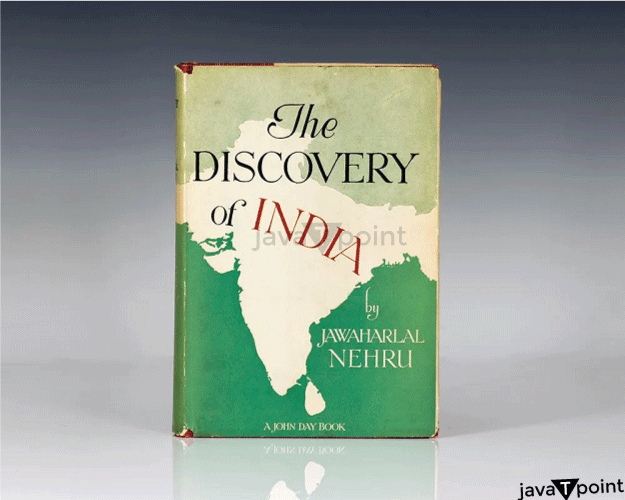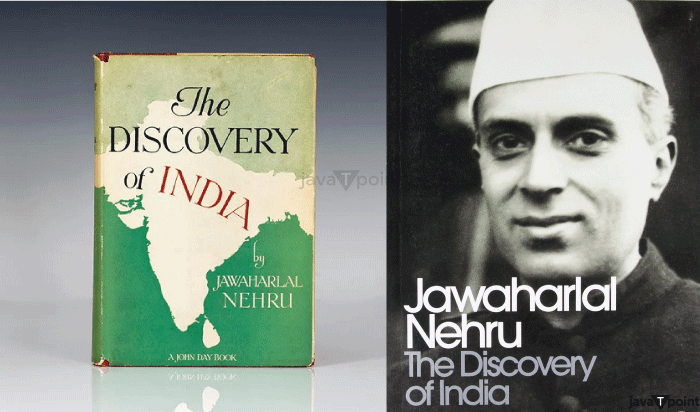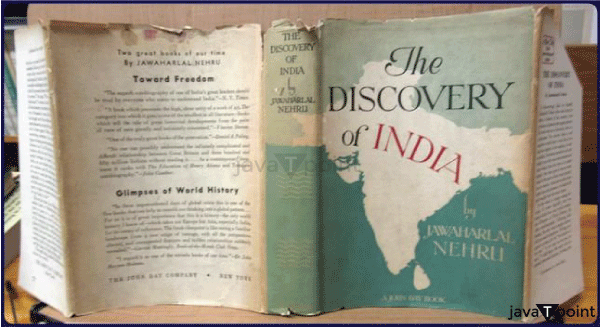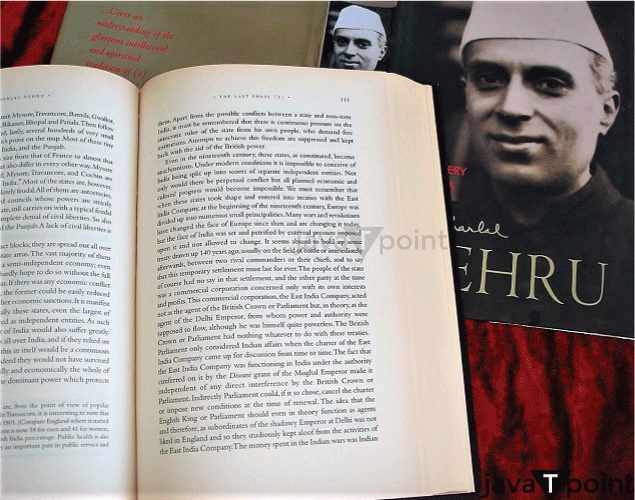The Discovery of India SummaryIntroductionThe book "The Discovery of India," authored by Jawaharlal Nehru, the country's first prime minister, is a journey through Indian history. While Nehru was detained at the Ahmednagar Fort in 1946, he wrote the book in over five months. With a consistent narrative flow, it is broken up into ten chapters. The historical information is presented chronologically, which provides a lovely perspective on India's past and pre-independence era. 
It is a work of enormous scope and expertise. It is a monumental treatise that examines one of the world's most ancient societies' history, philosophy, art, religion, science, economy, society, and movements. Nehru examines extensively the origins of his life and the history of his India, which ranges from the Vedic era to the British administration in India. For the sole purpose of completing his quest, Nehru restudies and interprets the most important Indian writings, including the Vedas, Upanishads, and the major Indian epics, the Ramayana and the Mahabharata. He also honored great Indian figures like Buddha, Chanakya, and Mahatma Gandhi, who were instrumental in the nation's development. Nehru ranks among the top prose authors due to his honest attempts to explore the origins of his existence around the globe. Nehru was a politician by accident, as he admitted, a thinker and a humanist by nature, and a patriot who fought tirelessly until independence was achieved. Even though he was not a learned scholar, his multifaceted intellect had much to offer trained historians, economists, and sociologists. Although he had no literary aspirations, he exhibited exceptional literary qualities and flavor in his compositions. Pandit Nehru's multifaceted and colorful personality is discovered in the book "The Discovery of India". Nehru never believed he was writing literature. His goal in The Discovery was to discover India personally discover India, and he used all of his skills and intelligence to try to do it. However, when he is writing, the hidden artist within him uses all of his other abilities; thus, completely, that literary prowess comes to him naturally. The Discovery cannot be categorized within a single literary genre. It is a formless composition with no apparent literary goals. SummaryWhen read, The Discovery of India is an oddly disjointed collection of historical details, philosophical hypotheses, and reflective essays on disparate subjects wrapped in lyrical prose that frequently reaches artistic heights. It is a thesis on Indian history and culture written by Nehru's catholic and global thinking. He views India as a "friendly foreigner," respects its wisdom, denounces its follies, and studies its past to use it as a springboard for action, pushing and steering history in creative new directions. The book's opening three chapters are entirely autobiographical. While the nation suffers from starvation and the globe is at war, Nehru is held captive in the Ahmednagar Fort. He muses about life's philosophy while rambling about India's past and present in a relaxed tone and democracy's future before starting to write. He describes the events of his life following his sentence of imprisonment at Almora in 1935, including the illness and passing of his wife and his travels to and from Switzerland. The book's third chapter is the introduction to the Discovery of India. Despite his attraction to it, he is working to avoid approaching India and slipping back into his rambling meditations about nationalism and internationalism general elections and trips. As a result, the first three chapters have a uniquely autobiographical tone and subject. Even after the first three chapters, Nehru remains central to the story and continues the autobiographical style. We get the impression that Nehru speaks openly and honestly about what he knows and feels. The Discovery does not relate the events in Nehru's life outside the first three chapters. But because it illuminates and shows his inner life, it is autobiographical about numerous facets of his character. Talking about the historical features of the book, The Discovery has several strengths and weaknesses. As a study of the numerous stages in the progressive evolution of the national consciousness from the early dawn of the 20th century, it can be viewed and enjoyed as an introduction to the cultural history of India and civilization until the heated 20th century, when British India was on the verge of freedom and advancement. It is merely a broad introduction written with the average reader in mind. Nehru is not an academic historian, and his intention is not to recount historical events carefully recount historical events. According to Nehru's work in The Discovery of India, "Hindu "is not mentioned in our earliest writings. The first time it is mentioned in Indian literature is in a Tantrik work from the ninth century A.D. "Hindu" refers to "a people" rather than the adherents of a specific religion. Hinduism was, in fact, an Aryan religion. He attributes the early Vedanta's basis for the resurrection of Hinduism; Shankara (or Shankaracharya) developed a philosophy known as Advaita Vedanta or non-dualist Vedanta. He claimed this ideology represented the prevalent view of Hinduism at the time. It was founded on pure monism, in which the Atman, the absolute soul, represented the only true reality. 
Then he presents Swami Vivekananda, who formed the non-sectarian Ramakrishna Mission of Service, and his brother's disciples. It was steeped in history and brimming with pride for India's past. In India, citizens had isolated themselves within their borders. India continued to reflect on its glorious past while the West embraced forward-thinking ideas, contributing to its later decline. Nehru believed that the rational Indian intellect had been extremely capable from ancient times, having even divided society into specialized sectors (which gave rise to the caste system). In contrast to the West, India did not practice widespread slavery. The caste system's engrained subordination, however, caused progress to stall. The sexism of Indian women is another fascinating feature mentioned in the book. He thought that the seclusion of women, or purdah, had halted social advancement. He speaks highly of the ladies who took part in the liberation struggle. And he mentions how his father, Motilal Nehru, despised women participating in rallies on the streets despite his paternal love for the women in his family and society. India also moved more and more into the countryside. The British policy caused the population to shift in the opposite direction, from city to villages and from industry to farmland. He discusses how the fact that Indians were content with their social lives further discouraged them from pursuing economic wealth. Regarding the Indian languages and art, Nehru mentions that because educated members of the upper caste only used it and it was not widely spoken, Sanskrit had long since died out. But in South East Asia, in nations like Indonesia, Java, Bali, Cambodia, and Malay, this language and the literature left a remarkable effect. Nehru has written extensively about the illustrious Southern empires and their influence on the development of the glorious past through allusions to literature, art, and architecture. He claims that we can see a lot of river trade by reading the extant literature. The Jatakas claim that ships departed from Banaras, Patna, Bhagalpur, and other locations and made their way to the sea before sailing to southern ports, Ceylon and Malaya. The thriving ports of Kaveripatnam on the Kaveri River in the south are described in old Tamil poetry. Silk, muslin, the better types of cloth, cutlery, armor, brocades, embroideries, rugs, perfumes, pharmaceuticals, ivory, and gold were among the exports from India. The Turkish invasion, the Afghan invasion, and finally, a Turco-Mongol or Mughal invasion is how Nehru explains this period. According to Nehru, Afghans who immigrated to India underwent an Indianization process. When Nehru characterizes passionate Allauddin Khilji's forced marriage to the kidnapped queen of Karna Dev Vaghela of Gujarat, and his son's identical marriage to her daughter, as a sign of synthesis between Afghans and Indians, he reaches the extreme of naivete and wishful vision. Due to the Hindu-Muslim issue at the time, Nehru may have painted a positive picture of the Muslim era in India. Being a politician, he was well aware that the candid depiction of the Muslim era may exacerbate an already contentious situation in which Indian Muslims identified with their invading forefathers. The Mughal Empire slowly fell apart. A thorough account of British control in India is provided in "The Discovery of India." It indicates that the East India Company founded British control in India. After initially settling in Bengal, the British gradually occupied India's coastline. Many of India's once-wealthy and successful states fell into extreme poverty during the British occupation. Both agriculture and the Indian industrial system suffered greatly. The princes had been replaced by stronger feudal lords that the British could easily control. Even though the Revolt of 1857-1858 contained certain nationalistic aspects, he refers to it as a feudal uprising. 
In the book, Nehru criticizes the British Planning Committee, claiming that the committee's goal was to guarantee a sufficient standard of living for the general populace and that economists estimated a per capita income of between Rs. 15 and Rs. 25 per month, which was significantly less than Western standards where it was approximately Rs. 65 per capita per year. In addition, he notes that the British had established a new caste or class in India: the English-educated class. This group was isolated from the general population and always had its back turned towards its overlords, even while it was revolting. However, he also mentions that a major shift in Indian thought and perspective, the arrival of printing presses, and new technical and scientific discoveries led to the development of modern consciousness. Some honorable men, including Raja Ram Mohan Roy, Chaitanya, and Ramkrishna, played a crucial part in social and religious reforms. Some great leaders' minds were also stimulated by education, and for the first time, Bengal's leaders emerged as the nation's authorities on cultural and political issues. These leaders' initiatives gave rise to the new nationalistic movement. The National Congress, a new leadership style for India's political freedom, is also highlighted by The Discovery of India. Under Gandhiji's direction, the Congress, which was initially in trouble, blossomed into a vibrant organization. He organized the conference to be democratic and inclusive. Industrial workers and peasants joined it. According to Nehru, the old guard under Dadabhai Naoroji was replaced by the new leadership under Bal Gangadhar Tilak, who was more aggressive in mobilizing agitations. Although it resulted in a conflict in 1907, Congress lost its relevance, and extremists gained strength. The Congress had then evolved into a vibrant organization under Gandhiji's direction. About the Muslim League, Nehru asserts that Jinnah left Congress not because of any disagreements regarding the Hindu-Muslim issue but rather. He could not embrace the new and more progressive ideology and, more importantly, because he detested the masses of shabby-dressed individuals speaking Hindustani who filled the Congress. His political philosophy was of a higher order and better suited for a committee meeting or a legislative chamber. He emphasizes how the Balkan conflicts and the Khilafat movement alienated Muslims from Congress. The Indian freedom movement of the 1940s is depicted in The Discovery of India as it occurred. Unquestionably, the National Congress was crucial to India's struggle for independence. In 1937, at the provincial elections held under the Government of India Act of 1935, the Congress party first gained control. The act of 1935 was a significant obstacle despite Congress' best efforts to address the issues in the provinces. Despite all of these obstacles and constraints, Indians were genuine and had a strong desire for total freedom. The assembly began to pay less attention to international developments as it became increasingly preoccupied with internal politics. It developed its foreign policy and demanded that no war be entered into by India without the approval of the elected representatives of the people. However, the British viceroy declared India belligerent in World War II without consulting the elected representatives, which led to the provincial government's resignation in protest. Chaos and turmoil followed the provincial government's departure from Congress. Tension permeated the nation as a whole. The British administration put down all of the Indian people's attempts at self-liberation. All of the notable leaders were imprisoned. Although the nation's citizens were dissatisfied, Gandhiji's writing gave them a new direction. Gandhiji sponsored a resolution in Congress stating that India should devote all of its resources to pursuing freedom. On August 8, 1942, the A.T.C.C. adopted the Quit India resolution in response. The entire country was in upheaval. Great leaders were all incarcerated. The younger generation played a significant role all over India. Thousands of Indians were killed by the British authorities to put down the uprising. They oppressed the Indians brutally, leading to their misery and degradation. At the end of the book, Nehru focuses on India's future as he anticipated the country's freedom shortly after providing a thorough overview of the Indian freedom struggle from when it started to when it acquired momentum and the movement's final years. In the book, Nehru expresses that if India is to flourish, it must learn about technological and scientific innovation from the West while also letting go of the historical baggage that has impeded its development. It means to continue doing what was important and life-giving in the past. 
ConclusionIn The Discovery of India, ideas and emotions coexist and produce a kind of creative harmony. Anything Nehru writes is made enjoyable and engaging by his honeyed muse. Despite his love of language, he uses words sparingly in his writing. It is always lucid, unaffected, and limpid. Words are at his disposal, and he uses them to express his true ideas and experience most understandably. The voyage Nehru took to discover India is chronicled in his book, The Discovery of India. The "discovery of Nehru's large, comprehensive, and catholic self" was in a real sense. He learned what India was and imagined what she would become during his voyage.
Next TopicThe Scarlet Letter Summary
|
 For Videos Join Our Youtube Channel: Join Now
For Videos Join Our Youtube Channel: Join Now
Feedback
- Send your Feedback to [email protected]
Help Others, Please Share









